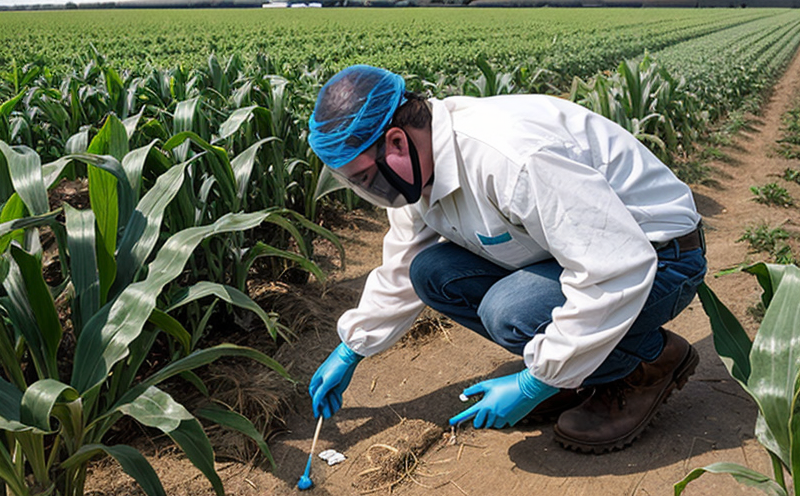Carbaryl Residue Testing in Crops
Carbaryl, commonly known as Sevin, is a widely used systemic insecticide in agriculture. It acts by inhibiting the production of acetylcholinesterase, leading to nerve dysfunction and ultimately death in insects. Despite its efficacy in controlling pests, carbaryl can persist in plant tissues, posing potential risks if residues exceed permissible limits.
The importance of testing for carbaryl residue cannot be overstated. Regulatory bodies worldwide have established maximum allowable levels (MALs) to ensure food safety and protect consumer health. In the United States, the Environmental Protection Agency (EPA) regulates carbaryl residues in crops under its pesticide registration program. Similarly, other countries like Canada and the European Union impose strict limits.
For instance, the U.S. EPA mandates that any food containing carbaryl residues must not exceed 0.5 ppm (parts per million) in fresh or frozen vegetables and fruits. This stringent regulation underscores the critical need for accurate, reliable, and precise residue testing.
The testing process involves several key steps: sampling, extraction, purification, and quantification. The most common analytical techniques include gas chromatography-mass spectrometry (GC-MS) and liquid chromatography-tandem mass spectrometry (LC-MS/MS). These methods offer high sensitivity and selectivity, enabling accurate detection even at trace levels.
Sample preparation is crucial for ensuring reliable results. Typically, crops such as fruits, vegetables, grains, and legumes are thoroughly washed before extraction. Extraction solvents like methanol or acetonitrile are used to dissolve carbaryl residues from the matrix. The extracts are then purified using solid-phase extraction (SPE) cartridges.
Once prepared, the samples undergo instrumental analysis. GC-MS provides detailed structural information about the compound, while LC-MS/MS allows for precise quantification by measuring the ionization efficiency and fragmentation patterns of carbaryl.
The results are reported in parts per million (ppm) or parts per billion (ppb), depending on the sensitivity required. Compliance with regulatory limits is essential to avoid legal penalties, consumer trust issues, and potential market disruptions.
Failure to comply can lead to recalls, fines, and reputational damage for agricultural producers and food processors. Therefore, regular residue testing ensures that products meet international standards and maintain consumer confidence.
Why Choose This Test
Testing for carbaryl residues in crops offers numerous benefits to stakeholders across the supply chain. Quality managers and compliance officers can ensure regulatory adherence, while R&D engineers gain insights into optimal application rates and crop rotation strategies. Procurement teams benefit from knowing the integrity of their suppliers.
Regular testing helps identify potential contamination sources early, allowing for corrective actions before they escalate into larger issues. It also enhances brand reputation by demonstrating commitment to food safety and sustainability.
In addition, compliance with international standards can open new markets or maintain existing ones. For instance, meeting EU regulations allows exporters to access European Union member states without facing import restrictions.
From a technical standpoint, advanced analytical techniques offer unparalleled precision and reliability. These methods not only detect carbaryl residues accurately but also differentiate between active ingredients and metabolites, providing a comprehensive overview of pesticide use practices.
International Acceptance and Recognition
The global agricultural industry recognizes the importance of residue testing for carbaryl. Regulatory agencies around the world have harmonized their standards to ensure consistency across borders. The International Organization for Standardization (ISO) and the Codex Alimentarius Commission play pivotal roles in setting international guidelines.
For example, ISO 3621 specifies the method for determining carbaryl residues by gas chromatography-mass spectrometry. Similarly, the FAO/WHO Joint Meeting on Pesticide Residues provides guidance on maximum residue limits (MRLs). These standards ensure that testing methods are consistent and reproducible, fostering trust among trading partners.
European Union guidelines, such as Regulation (EC) No 396/2005, mandate the use of validated analytical techniques. The U.S. EPA also requires laboratories to follow approved protocols for residue analysis. This international consensus ensures that carbaryl residues are tested consistently across different regions.
Recognizing the importance of harmonization, many countries have adopted these standards as part of their national regulations. This alignment not only simplifies compliance but also promotes fair trade practices by setting clear expectations for all participants in the global agricultural supply chain.
Use Cases and Application Examples
In practice, carbaryl residue testing is employed in various scenarios. Quality assurance departments frequently test incoming raw materials to ensure they meet specified quality standards before processing. This prevents the introduction of contaminated products into the supply chain.
R&D teams also use this service to optimize pesticide application rates and timing. By analyzing residues after harvest, they can refine spray schedules to minimize environmental impact while maintaining efficacy against pests.
For food processors and retailers, regular testing is essential for compliance with health and safety regulations. This ensures that their products remain safe for consumption and meet consumer expectations.
Agricultural cooperatives often employ this service as part of their certification programs. Certification guarantees that member farms adhere to strict pesticide use guidelines, enhancing marketability and reputation.
In case studies, one example involves a large-scale produce supplier who implemented carbaryl residue testing after detecting irregularities in past batches. By integrating this testing into their quality control protocols, they were able to pinpoint specific fields where contamination occurred and implement corrective measures promptly.





